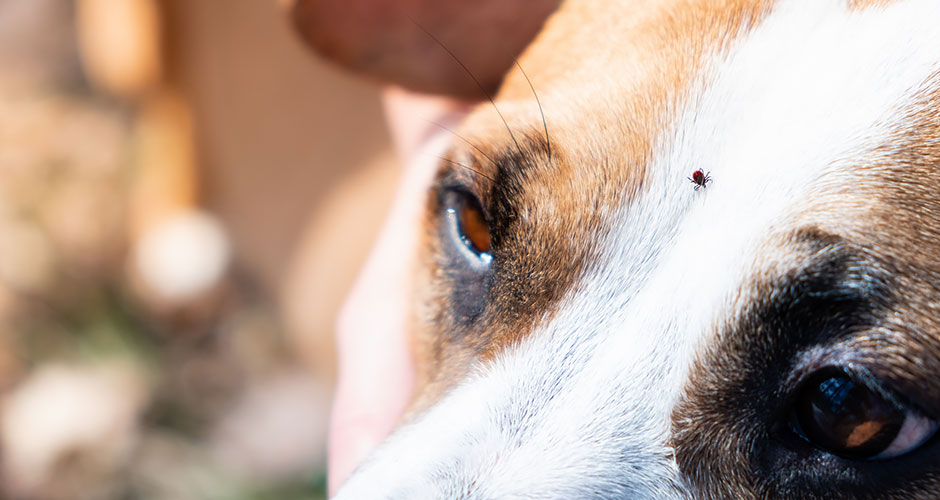
A tick can latch onto its host and feed for days before it’s noticed. Chances are, you’ll one day find a tick on your dog and wonder how long it has been attached - and whether it’s had enough time to put your dog at risk for disease.
In honor of Prevent Lyme in Dogs Month, learn how ticks find, attach and pass disease to our four-legged family members and what you can do to keep your dog safe.
How Do Ticks Get Attached To Dogs?
Though ticks are blind and they don’t fly or jump, it’s surprisingly easy for them to find and attach to a host. Ticks are attracted to heat and carbon dioxide, a chemical byproduct mammals (like dogs and humans) exhale from their lungs.
When a tick detects a potential host nearby, it springs into action, assuming the “questing” position. It scurries to the end of a branch or a leaf, extending its two front legs, poised to hitch a ride onto your dog as they brush past.
At first, ticks tend to crawl onto your dog’s legs, belly, groin, or face. Then, they tend to crawl upwards, targeting the head, neck, face, and ears, where the skin is thinner and it’s more difficult for your dog to reach them.
Ticks dig into the skin using two sets of hooks on either side of their mouth. Then, they anchor their straw-like mouth part into the skin.
As ticks feed, they secrete saliva. This saliva contains chemical compounds that numb the area, so their host is unlikely to notice they’ve been bitten. Tick saliva also prevents inflammation and blood clots to keep blood flowing while they feed.
How Long Do Ticks Stay Attached To Dogs?
An embedded tick can remain attached to your dog for several days. Adult female ticks attach and feed for as long as seven to ten days before dropping off to lay eggs.
A tick that has not yet begun feeding or has only been attached for a few hours will appear small and flat. After several days of feeding, ticks become large, rounded, and engorged and appear light brown or grey in color.
How Long Does It Take for Ticks To Spread Disease?
Most tick species will have three different hosts during a life cycle. Newly hatched larvae and nymphs, or young ticks, seek small animals like mice and birds.
Adult ticks that feed off dogs and people generally have already fed from several smaller hosts. A tick can transmit disease-causing pathogens between hosts, secreting infected saliva into the host’s bloodstream as it feeds.
It generally takes several days of feeding for a tick to transmit disease to its host. According to the CDC, a tick must remain attached for 36 to 48 hours to transmit the bacteria that causes Lyme disease. However, other diseases, including Ehrlichiosis and Rocky Mountain Spotted Fever, can be transmitted through a tick bite within just a few hours.
If you find a tick on your dog, remove it with tweezers or a tick tool. Take care not to squeeze the body. Do not apply rubbing alcohol or any other chemical, as a stressed tick may regurgitate its stomach contents into your dog’s bloodstream, potentially spreading disease.
Symptoms of a tickborne illness can take weeks, even months, to show up. If you can successfully remove the tick at home before it has engorged, your dog may not need to see a vet. In the meantime, monitor your dog for signs of illness. Safely dispose of the tick or store the tick’s body in a plastic baggie in your fridge or freezer if needed for identification or testing.
Protect Your Dog Against Tickborne Disease
By using a flea and tick preventative, you can greatly reduce your dog’s chances of contracting a tick-borne disease. Flea and tick preventatives generally kill ticks within 24 hours of a bite. The tick will fall off and die before it can transmit disease.
If your dog frequents areas that may have ticks, like beaches, fields, and wooded hiking trails - even if your dog never walks off the trail - consider also using a topical product that repels ticks. Only use products that are safe to use at the same time as other flea and tick prevention.
During and after an outing, check your dog thoroughly for ticks. A hungry tick can be as small as a sesame seed and difficult to spot, especially if your dog has long or dark-colored fur.
Talk to your veterinarian or make a same-day televet appointment today for advice on choosing flea and tick products. Your vet can also tell you which tick species are prevalent in your region and give you advice based on your dog’s risk of exposure to tick-borne disease.





































